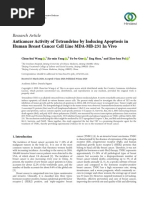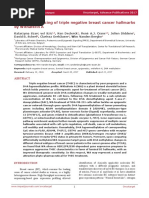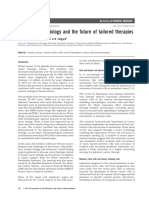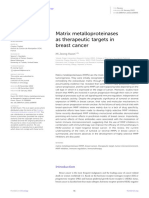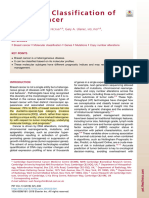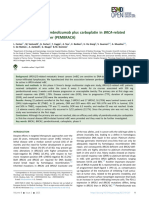Ijms 24 02542
Ijms 24 02542
Uploaded by
Frank MacíasCopyright:
Available Formats
Ijms 24 02542
Ijms 24 02542
Uploaded by
Frank MacíasOriginal Title
Copyright
Available Formats
Share this document
Did you find this document useful?
Is this content inappropriate?
Copyright:
Available Formats
Ijms 24 02542
Ijms 24 02542
Uploaded by
Frank MacíasCopyright:
Available Formats
International Journal of
Molecular Sciences
Editorial
Breast Cancer: From Pathophysiology to Novel Therapeutic
Approaches 2.0
Antonella Zannetti
Institute of Biostructures and Bioimaging, National Research Council (IBB-CNR), 80145 Naples, Italy;
antonella.zannetti@cnr.it
Breast cancer (BC) is the most common malignancy in women worldwide. It is a
very heterogeneous disease characterized by different molecular profiles that are clinically
divided into three main subtypes by hormone receptor (ER and PR) and HER2 (ERBB2)
status: luminal ER-positive and PR-positive, which is further subdivided into luminal
A and B, HER2-positive, and triple-negative breast cancer (TNBC) [1]. To date, in the
fight against breast cancer, the screening program is the most important aid in reducing
mortality caused by this disease. Conventional chemo- and radiotherapy, often including
targeted agents, represent the main systemic treatment used for BC patients, although
many develop drug resistance, relapse, and secondary metastases [1]. The early stage of
BC is considered curable in 70–80% of patients due to improved multimodal therapy, while
advanced metastatic BC is an unmet challenge. Many studies are ongoing, and efforts are
being made to identify new molecular biomarkers to improve diagnostic and therapeutic
approaches. Therefore, the aim of this Special Issue is to highlight the current preclinical
and clinical studies conducted in breast cancer research to shed light on the deep molecular
signatures and the next therapeutic scenario of this highly heterogeneous disease.
All of the articles published in “Breast Cancer: From Pathophysiology to Novel
Therapeutic Approaches 2.0” meet these criteria and report interesting results, often using
transcriptomic approaches, on the identification and implication of novel biomarkers that
are able to discriminate between different types of BC and between responder and non-
responder patients. In addition, new possible prognostic factors related to overall survival
have been investigated, but most importantly, new targeted and less toxic therapies have
Citation: Zannetti, A. Breast Cancer:
been evaluated for use alone or in combination with chemotherapeutic agents.
From Pathophysiology to Novel
In an interesting review, Chiodo et colleagues [2] clarified the contribution of steroid
Therapeutic Approaches 2.0. Int. J.
hormones and their receptors in the growth, development, and lifetime changes of the
Mol. Sci. 2023, 24, 2542.
mammary gland as well as its crucial role in breast cancer development and progression.
https://doi.org/10.3390/
They elucidated the controversial impact of androgens/AR in preventing or promoting
ijms24032542
breast cancer and the signaling pathways involved.
Received: 5 December 2022 It is noteworthy that by analyzing the TCGA/GTEx datasets available within GEPIA2
Revised: 23 December 2022 and using the tissue microarray of a cohort of 252 samples, a study showed that breast
Accepted: 13 January 2023 cancer patients with higher methionine adenosyltransferases 2 (MAT2A) and no MAT1A
Published: 29 January 2023
had a worse survival rate (p = 0.0057). The authors found that a higher cytoplasmic/nuclear
(C/N) MAT2A protein expression ratio correlated with poor overall survival, and a MAT2A
C/N expression ratio ≥ 1.0 was determined as an independent risk factor by Cox regression
analysis [3].
Copyright: © 2023 by the author.
Licensee MDPI, Basel, Switzerland.
del Mar Noblejas-López et al. [4] demonstrated, using the transcriptomic mapping
This article is an open access article
of cyclin-dependent kinases (CDKs), that the expression of CDK9 predicted a detrimental
distributed under the terms and outcome in basal-like breast cancer and, particularly, in the luminal B subtype with HER2+
conditions of the Creative Commons expression. They found that a novel proteolysis targeting chimera (PROTAC) compound
Attribution (CC BY) license (https:// against CDK9, THAL-SNS-032, showed a major anti-tumoral effect on breast cancer cell
creativecommons.org/licenses/by/ lines, expressing both ER and HER2, such as BT474. Interestingly, drug-resistant cells
4.0/). derived from BT474 cell line with resistance to trastuzumab (BT474-RH), to the antibody
Int. J. Mol. Sci. 2023, 24, 2542. https://doi.org/10.3390/ijms24032542 https://www.mdpi.com/journal/ijms
Int. J. Mol. Sci. 2023, 24, 2542 2 of 3
drug conjugate TDM1 (BT474-TDM1R), or to the kinase inhibitor lapatinib (BT474-LAPA-R)
displayed a particular sensitivity to THALSNS-032. Conversely, low doses of the com-
pound induced severe toxicity in BT474 xenografts, in particular in in the gastrointestinal
epithelium, without causing a significant reduction of tumor volume, thus showing its
inverse therapeutic index.
A synergic antitumoral effect of Ruxolitinib (an oral selective inhibitor of Janus kinases
1 and 2) and Calcitriol in HER2-enriched and triple negative subtypes of breast cancer
cells was reported by Schneider and colleagues [5]. The combined treatment caused cell
proliferation inhibition, apoptosis induction, cell cycle arrest, and the alteration of the cell
signaling protein expression underlying these mechanisms. Similar results were obtained
in vivo with Ruxolitinib and Calcitriol that showed a synergistic inhibitory effect on tumor
growth in MDA-MB-468 xenografts, corroborating the in vitro observations on the potential
of this treatment in certain subtypes of breast cancer.
To improve the selectivity and bioavailability of chemotherapeutic agents, such as
the platinum complexes class and overcome multiple mechanisms of drug resistance,
Czarnomysy et al. [6] synthesized a novel imidazole platinum(II) complex conjugated
with the second-generation polyamidoamine (PAMAM) dendrimer (PtMet2–PAMAM).
They showed that this compound increased apoptosis via caspase-9 (intrinsic pathway)
and caspase-8 (extrinsic pathway) as well as triggered autophagy through p38 pathway
activation in different breast cancer cells. Furthermore, the complex inhibited drug efflux
transporters and its positive charge increased the tumor cell uptake, demonstrating the
ability of PtMet2–PAMAM to reverse multidrug resistance [6].
TNBC represents one of the most aggressive types of BC because of its high hetero-
geneity and plasticity [7]. Currently, chemotherapy still remains the main therapeutic
option, including taxane- and anthracycline-based treatments for TNBC, despite the high
rate of non-responders due to the occurrence of drug resistance. Interestingly, a study by
Gangapuram et al. [8] compared the transcriptome profile of TNBC cells in response a
novel cytostatic compound, a tetrahydroisoquinoline named GM-4-53, and paclitaxel. Both
treatments caused, in TNBC cells, changes in transcripts that influence microtubule spindle
formation, chromosome segregation, mitosis/cell cycle, and transforming growth factor
(TGF) signaling as well as the downregulation of “inhibitor of DNA Binding/Inhibitor
of differentiation” (ID) transcripts, amphiregulin (AREG) and epiregulin (EREG), with
GM-4-53 having more significant effects than paclitaxel. The authors hypothesize that
given the efficient solubility of GM-4-53, its low molecular weight (MW; 296) and its abil-
ity to penetrate a small solid tumor mass and effectively block the cell cycle, this drug
may have future therapeutic value in treating TNBC. The effect of desethylamiodarone
(DEA), the major metabolite of amiodarone (AM), as anti-tumoral agent was investigated
by Gallyas and colleagues [9] in TNBC cells. They found that DEA reduced tumor cell
viability, proliferation, and invasion; lowered mitochondrial transmembrane potential; and
induced mitochondrial fragmentation. In addition, DEA-resistant TNBC cells showed an
upregulation of cyclooxygenase 2 (COX-2) and its activity was counteracted by the specific
inhibitor celecoxib.
Several innovative approaches are being explored to overcome limitations due to
the lack of well-defined TNBC biomarkers. Recently, Camorani et al., using a TNBC cell-
SELEX approach, generated a panel of six RNA aptamers able to bind at high efficiency
to the surface proteins of human TNBC cells without recognizing non-malignant cells or
non-TNBC breast cancer cells [10]. Aptamers recognize their targets with high affinity
and specificity in a manner similar to antibody–antigen interactions and have been used
to specifically deliver through nanovector-based chemotherapeutic agents and immune
checkpoint inhibitors in TNBC cells [11,12]. In a study published in this Special Issue,
Camorani et colleagues [13] optimized three of six aptamers by shortening and proved that
the truncated aptamers showed superb nuclease resistance, specific binding to TNBC target
cells, and rapid internalization into acidic compartments and also hampered the growth of
TNBC cells as mammospheres.
Int. J. Mol. Sci. 2023, 24, 2542 3 of 3
In conclusion, taken together, the studies published in this Special Issue demonstrate
that the future of research in BC, through the deeper knowledge of molecular mechanisms
associated with drug resistance and underlying tumor progression, is reaching the point
where treatments can be tailored to each individual patient.
Conflicts of Interest: The author declares no conflict of interest.
References
1. Loibl, S.; Poortmans, P.; Morrow, M.; Denkert, C.; Curigliano, G. Breast cancer. Lancet 2021, 397, 1750. [CrossRef] [PubMed]
2. Chiodo, C.; Morelli, C.; Cavaliere, F.; Sisci, D.; Lanzino, M. The Other Side of the Coin: May Androgens Have a Role in Breast
Cancer Risk? Int. J. Mol. Sci. 2021, 23, 424. [CrossRef] [PubMed]
3. Chu, P.Y.; Wu, H.J.; Wang, S.M.; Chen, P.M.; Tang, F.Y.; Chiang, E.I. MAT2A Localization and Its Independently Prognostic
Relevance in Breast Cancer Patients. Int. J. Mol. Sci. 2021, 22, 5382. [CrossRef] [PubMed]
4. Noblejas-López, M.D.M.; Gandullo-Sánchez, L.; Galán-Moya, E.M.; López-Rosa, R.; Tébar-García, D.; Nieto-Jiménez, C.; Gómez-
Juárez, M.; Burgos, M.; Pandiella, A.; Ocaña, A. Antitumoral Activity of a CDK9 PROTAC Compound in HER2-Positive Breast
Cancer. Int. J. Mol. Sci. 2022, 23, 5476. [CrossRef] [PubMed]
5. Schneider, J.; Jeon, Y.W.; Suh, Y.J.; Lim, S.T. Effects of Ruxolitinib and Calcitriol Combination Treatment on Various Molecular
Subtypes of Breast Cancer. Int. J. Mol. Sci. 2022, 23, 2535. [CrossRef] [PubMed]
6. Czarnomysy, R.; Muszyńska, A.; Rok, J.; Rzepka, Z.; Bielawski, K. Mechanism of Anticancer Action of Novel Imidazole
Platinum(II) Complex Conjugated with G2 PAMAM-OH Dendrimer in Breast Cancer Cells. Int. J. Mol. Sci. 2021, 22, 5581.
[CrossRef] [PubMed]
7. Sarnella, A.; D’Avino, G.; Hill, B.S.; Alterio, V.; Winum, J.Y.; Supuran, C.T.; De Simone, G.; Zannetti, A. A Novel Inhibitor of
Carbonic Anhydrases Prevents Hypoxia-Induced TNBC Cell Plasticity. Int. J. Mol. Sci. 2020, 21, 8405. [CrossRef] [PubMed]
8. Gangapuram, M.; Mazzio, E.A.; Redda, K.K.; Soliman, K.F.A. Transcriptome Profile Analysis of Triple-Negative Breast Cancer
Cells in Response to a Novel Cytostatic Tetrahydroisoquinoline Compared to Paclitaxel. Int. J. Mol. Sci. 2021, 22, 7694. [CrossRef]
[PubMed]
9. Gallyas, F., Jr.; Ramadan, F.H.J.; Andreidesz, K.; Hocsak, E.; Szabo, A.; Tapodi, A.; Kiss, G.N.; Fekete, K.; Bognar, R.;
Szanto, A.; et al. Involvement of Mitochondrial Mechanisms and Cyclooxygenase-2 Activation in the Effect of Desethylamio-
darone on 4T1 Triple-Negative Breast Cancer Line. Int. J. Mol. Sci. 2022, 23, 1544. [CrossRef] [PubMed]
10. Camorani, S.; Granata, I.; Collina, F.; Leonetti, F.; Cantile, M.; Botti, G.; Fedele, M.; Guarracino, M.R.; Cerchia, L. Novel Aptamers
Selected on Living Cells for Specific Recognition of Triple-Negative Breast Cancer. iScience 2020, 23, 100979. [CrossRef] [PubMed]
11. Agnello, L.; Tortorella, S.; d’Argenio, A.; Carbone, C.; Camorani, S.; Locatelli, E.; Auletta, L.; Sorrentino, D.; Fedele, M.;
Zannetti, A.; et al. Optimizing cisplatin delivery to triple-negative breast cancer through novel EGFR aptamer-conjugated
polymeric nanovectors. J. Exp. Clin. Cancer Res. 2021, 40, 239. [CrossRef] [PubMed]
12. Camorani, S.; Tortorella, S.; Agnello, L.; Spanu, C.; d’Argenio, A.; Nilo, R.; Zannetti, A.; Locatelli, E.; Fedele, M.;
Franchini, M.C.; et al. Aptamer-Functionalized Nanoparticles Mediate PD-L1 siRNA Delivery for Effective Gene Silenc-
ing in Triple-Negative Breast Cancer Cells. Pharmaceutics 2022, 14, 2225. [CrossRef] [PubMed]
13. Camorani, S.; d’Argenio, A.; Agnello, L.; Nilo, R.; Zannetti, A.; Ibarra, L.E.; Fedele, M.; Cerchia, L. Optimization of Short RNA
Aptamers for TNBC Cell Targeting. Int. J. Mol. Sci. 2022, 23, 3511. [CrossRef] [PubMed]
Disclaimer/Publisher’s Note: The statements, opinions and data contained in all publications are solely those of the individual
author(s) and contributor(s) and not of MDPI and/or the editor(s). MDPI and/or the editor(s) disclaim responsibility for any injury to
people or property resulting from any ideas, methods, instructions or products referred to in the content.
You might also like
- Antibody-Drug Conjugates in Triple Negative Breast Cancer: Review ArticleDocument12 pagesAntibody-Drug Conjugates in Triple Negative Breast Cancer: Review Articleerikglu2796No ratings yet
- (In Vivo) 6823520Document11 pages(In Vivo) 6823520ingelitaNo ratings yet
- Cytotoxicity of New Pyridazin 3 (2H) One Derivatives Orchestrating Oxidative Stress in Human Triple Negative Breast Cancer (MDA MB 468)Document1 pageCytotoxicity of New Pyridazin 3 (2H) One Derivatives Orchestrating Oxidative Stress in Human Triple Negative Breast Cancer (MDA MB 468)youness.boukharsaNo ratings yet
- Metformin Review AeticleDocument17 pagesMetformin Review AeticleSarla YadavNo ratings yet
- 2023 Monteleone Tagerted Therapy of IL34 As A Prmosing Approach To Overcome Cancer ResistanceDocument12 pages2023 Monteleone Tagerted Therapy of IL34 As A Prmosing Approach To Overcome Cancer Resistancephilippe.lacroix38490No ratings yet
- Immunotherapy in Triple-Negative Breast Cancer - Insights Into Tumor Immune Landscape and Therapeutic OpportunitiesDocument25 pagesImmunotherapy in Triple-Negative Breast Cancer - Insights Into Tumor Immune Landscape and Therapeutic OpportunitiesLee Foo WengNo ratings yet
- Therapeutic Potential of Melatonin Counteracting Chemotherapy-Induced Toxicity in Breast Cancer Patients a Systematic ReviewDocument14 pagesTherapeutic Potential of Melatonin Counteracting Chemotherapy-Induced Toxicity in Breast Cancer Patients a Systematic Reviewluizhenrique.luckmannNo ratings yet
- Fimmu 11 577869Document18 pagesFimmu 11 577869nataliaNo ratings yet
- tmp3CB2 TMPDocument20 pagestmp3CB2 TMPFrontiersNo ratings yet
- Early Stage TNBC - Management and Future Directions 2020Document21 pagesEarly Stage TNBC - Management and Future Directions 2020VistieruBeatriceNo ratings yet
- PIIS2451945622000915Document2 pagesPIIS2451945622000915FrancoNo ratings yet
- Artigo Molecular Cancer Therapeutics 2015Document7 pagesArtigo Molecular Cancer Therapeutics 2015brunokariaNo ratings yet
- Metformin Review Atricle 1Document32 pagesMetformin Review Atricle 1Sarla YadavNo ratings yet
- Biomedicines 11 00890Document19 pagesBiomedicines 11 00890김현수No ratings yet
- Bergh 2013Document4 pagesBergh 2013bixagif369No ratings yet
- Triple-Negative Breast Cancer and Emerging Therapeutic Strategies ATR and CHK12 As Promising TargetsDocument22 pagesTriple-Negative Breast Cancer and Emerging Therapeutic Strategies ATR and CHK12 As Promising TargetsscadvijayNo ratings yet
- Novel Immunotherapeutics in B-Cell Precursor ALLDocument23 pagesNovel Immunotherapeutics in B-Cell Precursor ALLqcywh2000No ratings yet
- 20-07-2020 025934231 - Bcl-2Document11 pages20-07-2020 025934231 - Bcl-2Mohammad Ahmad SharroufNo ratings yet
- Fonc 12 1108695Document16 pagesFonc 12 1108695oncologynsambyaNo ratings yet
- Cancers 15 04682Document15 pagesCancers 15 04682afrinamithunNo ratings yet
- Cholecystokinin Receptor Antagonist Improves Efficacy of Chemotherapy in Murine Models of Pancreatic Cancer by Altering The Tumor MicroenvironmentDocument21 pagesCholecystokinin Receptor Antagonist Improves Efficacy of Chemotherapy in Murine Models of Pancreatic Cancer by Altering The Tumor MicroenvironmentJaya Kunal DubeyNo ratings yet
- Cancers 12 03271Document16 pagesCancers 12 03271evapruvost2No ratings yet
- biomedicines-12-00183Document28 pagesbiomedicines-12-00183mozaman1999No ratings yet
- Molecular Classification of BCDocument14 pagesMolecular Classification of BCbrendaNo ratings yet
- Ijms 23 09617Document3 pagesIjms 23 09617vwjpksbrNo ratings yet
- Metastatic Breast Cancer Cytology Diagnosis With ImplicationsDocument14 pagesMetastatic Breast Cancer Cytology Diagnosis With ImplicationsHiba MimineNo ratings yet
- PMC CancerDocument2 pagesPMC CancervivekNo ratings yet
- Preclinical Evaluation of The CDK4:6 Inhibitor Palbociclib in Combination With A PI3K or MEK Inhibitor in Colorectal CancerDocument12 pagesPreclinical Evaluation of The CDK4:6 Inhibitor Palbociclib in Combination With A PI3K or MEK Inhibitor in Colorectal CancermicrosunboatNo ratings yet
- Citar Esse em TerceiroDocument16 pagesCitar Esse em TerceirostefaniebmsNo ratings yet
- Pembrolizumab For Advanced Cervical Cancer Safety and EfficacyDocument9 pagesPembrolizumab For Advanced Cervical Cancer Safety and EfficacyluizaNo ratings yet
- Breast Cancer Treatments - Updates and New Challenges - PMCDocument75 pagesBreast Cancer Treatments - Updates and New Challenges - PMCWadood Md ZahedNo ratings yet
- A Clinically Relevant Gene Signature in Triple Negative and Basal-Like Breast CancerDocument16 pagesA Clinically Relevant Gene Signature in Triple Negative and Basal-Like Breast CancerAlexandra TeodorescuNo ratings yet
- The Role of CD44 in Cancer Chemoresistance A Concise ReviewDocument13 pagesThe Role of CD44 in Cancer Chemoresistance A Concise ReviewZihao WuNo ratings yet
- Fimmu 14 1140541Document11 pagesFimmu 14 1140541Wang JianweiNo ratings yet
- Grzyb I Rak2Document11 pagesGrzyb I Rak2Matt NeputinNo ratings yet
- Apicella 2015Document16 pagesApicella 2015bawoji1763No ratings yet
- My Article 5Document23 pagesMy Article 5Fatima NNo ratings yet
- Synergistic Immunostimulatory Effects and Therapeutic Benefit of 2 Combined Histone Deacetylase and Bromodomain Inhibition in Non-Small Cell 3 Lung CancerDocument42 pagesSynergistic Immunostimulatory Effects and Therapeutic Benefit of 2 Combined Histone Deacetylase and Bromodomain Inhibition in Non-Small Cell 3 Lung Cancershidis1028No ratings yet
- TNBCDocument13 pagesTNBCSilvi Zakiyatul IlmiyahNo ratings yet
- MainDocument7 pagesMainKamila MuyasarahNo ratings yet
- JNP MaximiscinDocument6 pagesJNP Maximiscinsah987No ratings yet
- Harnessing Bene Fit From Targeting Tumor Associated Carbohydrate AntigensDocument9 pagesHarnessing Bene Fit From Targeting Tumor Associated Carbohydrate Antigensspin_echoNo ratings yet
- Article 05Document6 pagesArticle 05KonTissa IlianaNo ratings yet
- 2016 Fasting Boosts Sensitivity of Human Skin Melanoma To Cisplatin - Induced Cell DeathDocument7 pages2016 Fasting Boosts Sensitivity of Human Skin Melanoma To Cisplatin - Induced Cell DeathKarin HerreraNo ratings yet
- Review Article Beta-Blockers and Berberine: A Possible Dual Approach To Contrast Neuroblastoma Growth and ProgressionDocument11 pagesReview Article Beta-Blockers and Berberine: A Possible Dual Approach To Contrast Neuroblastoma Growth and Progressiongonzalez1No ratings yet
- Ciardiello2019 PDFDocument11 pagesCiardiello2019 PDFVHINTA FADILA ERZANo ratings yet
- Upregulation of C/EBP A Inhibits Suppressive Activity of Myeloid Cells and Potentiates Antitumor Response in Mice and Patients With CancerDocument18 pagesUpregulation of C/EBP A Inhibits Suppressive Activity of Myeloid Cells and Potentiates Antitumor Response in Mice and Patients With CancerEdna PiedadNo ratings yet
- Biomedicines 12 00697Document12 pagesBiomedicines 12 00697jamel-shamsNo ratings yet
- SMYD3 Drives The Proliferation in Gastric Cancer Cells Via Reducing EMP1 Expression in An H4K20me3-dependent MannerDocument13 pagesSMYD3 Drives The Proliferation in Gastric Cancer Cells Via Reducing EMP1 Expression in An H4K20me3-dependent Mannerruofanwang1216No ratings yet
- Metformin Inhibits Metastatic Breast Cancer Progression and Improves Chemosensitivity by Inducing Vessel Normalization Via PDGF-B DownregulationDocument17 pagesMetformin Inhibits Metastatic Breast Cancer Progression and Improves Chemosensitivity by Inducing Vessel Normalization Via PDGF-B DownregulationJackson HakimNo ratings yet
- Nihms 1517499Document38 pagesNihms 1517499diptanj134No ratings yet
- 1-S2.0-S0014299923002297-Main (1) (1) - CompressedDocument13 pages1-S2.0-S0014299923002297-Main (1) (1) - CompressedSaif WahidNo ratings yet
- Precision Oncology: Targeted Therapies For Cancer (WWW - Kiu.ac - Ug)Document5 pagesPrecision Oncology: Targeted Therapies For Cancer (WWW - Kiu.ac - Ug)publication1No ratings yet
- Cancers-13-00147 BHS INGGRISDocument19 pagesCancers-13-00147 BHS INGGRISYunita MesseNo ratings yet
- Nihms 1727218Document27 pagesNihms 1727218yaacoubsergeNo ratings yet
- Immune Checkpoint Inhibitors For Triple-Negative Breast Cancer - From Immunological Mechanisms To Clinical EvidenceDocument13 pagesImmune Checkpoint Inhibitors For Triple-Negative Breast Cancer - From Immunological Mechanisms To Clinical EvidenceasdffdsaNo ratings yet
- TQ Clinical 2013Document4 pagesTQ Clinical 2013exirraikaNo ratings yet
- Ca Immunotherapy Beyond PDFDocument25 pagesCa Immunotherapy Beyond PDFJamil ANo ratings yet
- Real World Data On Outcomes of Anti-CD38 Antibody TreatedDocument14 pagesReal World Data On Outcomes of Anti-CD38 Antibody TreatedproductionNo ratings yet
- Gastroesophageal Cancer (Case Study)Document66 pagesGastroesophageal Cancer (Case Study)Michelle DuNo ratings yet
- Status Ujian Cindy MaharaniDocument6 pagesStatus Ujian Cindy MaharaniCindy MaharaniNo ratings yet
- PHD Thesis Western BlotDocument6 pagesPHD Thesis Western Blotdwrxjhgr100% (2)
- Bone Cancer (Osteosarcoma) : Carolea Casas & Brittany HogueDocument222 pagesBone Cancer (Osteosarcoma) : Carolea Casas & Brittany Hoguegiggs_libraNo ratings yet
- Protig 205Document32 pagesProtig 205Dale BergerNo ratings yet
- Psycho-Oncology NotesDocument18 pagesPsycho-Oncology NotesAakanksha SinglaNo ratings yet
- Stereotactic Radiotherapy On Brain Metastases With Recent Hemorrhagic Signal: STEREO-HBM, A Two-Step Phase 2 TrialDocument9 pagesStereotactic Radiotherapy On Brain Metastases With Recent Hemorrhagic Signal: STEREO-HBM, A Two-Step Phase 2 TrialHanyAbdallahNo ratings yet
- Logistic+Regression+Practice+Exercise+ +solutions - Ipynb ColaboratoryDocument5 pagesLogistic+Regression+Practice+Exercise+ +solutions - Ipynb ColaboratorySHEKHAR SWAMINo ratings yet
- Clinicopathological Significance of Peritumoral Alveolar Macrophages in Patients With Resected Early-Stage Lung Squamous Cell CarcinomaDocument19 pagesClinicopathological Significance of Peritumoral Alveolar Macrophages in Patients With Resected Early-Stage Lung Squamous Cell CarcinomaWilliamRayCassidyNo ratings yet
- WithasomaDocument4 pagesWithasomaroycNo ratings yet
- Melphalan PDFDocument1 pageMelphalan PDFZeny ArtilleraNo ratings yet
- Diffuse Sclerosing Variant of Papillary Thyroid CarcinomaDocument2 pagesDiffuse Sclerosing Variant of Papillary Thyroid CarcinomaYAŞAR TÜRKNo ratings yet
- Classification of Neoplasia: Neoplasia: Gross & Histological PreparationsDocument30 pagesClassification of Neoplasia: Neoplasia: Gross & Histological PreparationsdostoviskyNo ratings yet
- Journal 6Document8 pagesJournal 6Muhammad FaisalNo ratings yet
- Penile CancerDocument58 pagesPenile CancerPatrascu CristiNo ratings yet
- MM Healthcare: Stock Statement As On Date 31-Aug-2021Document56 pagesMM Healthcare: Stock Statement As On Date 31-Aug-2021Lokesh Kumar100% (1)
- 2.2 All Cells Arise From Other CellsDocument63 pages2.2 All Cells Arise From Other CellsJeekiesNo ratings yet
- Busting Breast Cancer Myths: A Deep Dive Into Epidemiology, Risk Factors and Effective ManagementDocument20 pagesBusting Breast Cancer Myths: A Deep Dive Into Epidemiology, Risk Factors and Effective ManagementInternational Journal of Innovative Science and Research TechnologyNo ratings yet
- Depth of Invasion in Oral Squamous Cell CarcinomaDocument63 pagesDepth of Invasion in Oral Squamous Cell CarcinomaDR. ISHITA SINGHALNo ratings yet
- CA Endometrio Guia Europea.Document28 pagesCA Endometrio Guia Europea.MartinNo ratings yet
- Bahan Ajar Praktikum Neurologi 2023Document23 pagesBahan Ajar Praktikum Neurologi 2023indahpratiwi.zhaa11No ratings yet
- Lung CancerDocument4 pagesLung CancerEgglijahNo ratings yet
- Stana VidhradiDocument9 pagesStana VidhradiShivaranjan KsNo ratings yet
- ONCOLOGY Board Exam QuestionDocument11 pagesONCOLOGY Board Exam QuestionEJ S Molina93% (15)
- Malignant Breast DiseasesDocument49 pagesMalignant Breast DiseasesEsha Bhatia100% (1)
- Breast Elastography A Literature ReviewDocument5 pagesBreast Elastography A Literature Reviewc5haeg0n100% (1)
- Tumores Histiociticos: DR Josue Ivan Leal Ventura R1 Neurocirugia Hospital Civil Fray Antonio AlcaldeDocument42 pagesTumores Histiociticos: DR Josue Ivan Leal Ventura R1 Neurocirugia Hospital Civil Fray Antonio AlcaldeJosue Ivan LealNo ratings yet
- Duan, 2021Document26 pagesDuan, 2021farihameetsworldNo ratings yet
- Lugols Solution Schillers Test IFU V9 EN4Document1 pageLugols Solution Schillers Test IFU V9 EN4Mary's CatzNo ratings yet
- Lymphoma: Diagnosis and TreatmentDocument8 pagesLymphoma: Diagnosis and TreatmentDindaNo ratings yet

